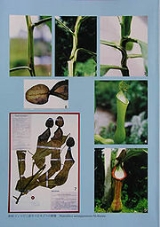
Nepenthes saranganiensis
Encyclopedia
Nepenthes saranganiensis ' onMouseout='HidePop("92359")' href="/topics/Sarangani">Sarangani
) is a tropical pitcher plant
native to the Philippine
island of Mindanao
. It is very closely related to N. alata
, but can be distinguished from that taxon
on the basis of its extremely decurrent leaf attachment.
Nepenthes saranganiensis has no known natural hybrids. No forms or varieties have been described.
Sarangani
In 1945, Filipino troops of the 6th, 10th, 101st and 102nd Infantry Division of the Philippine Commonwealth Army and 10th Infantry Regiment of the Philippine Constabulary entered and liberated in Southern Cotabato In 1945, Filipino troops of the 6th, 10th, 101st and 102nd Infantry Division of the...
) is a tropical pitcher plant
Pitcher plant
Pitcher plants are carnivorous plants whose prey-trapping mechanism features a deep cavity filled with liquid known as a pitfall trap. It has been widely assumed that the various sorts of pitfall trap evolved from rolled leaves, with selection pressure favouring more deeply cupped leaves over...
native to the Philippine
Philippines
The Philippines , officially known as the Republic of the Philippines , is a country in Southeast Asia in the western Pacific Ocean. To its north across the Luzon Strait lies Taiwan. West across the South China Sea sits Vietnam...
island of Mindanao
Mindanao
Mindanao is the second largest and easternmost island in the Philippines. It is also the name of one of the three island groups in the country, which consists of the island of Mindanao and smaller surrounding islands. The other two are Luzon and the Visayas. The island of Mindanao is called The...
. It is very closely related to N. alata
Nepenthes alata
Nepenthes alata is a tropical pitcher plant endemic to the Philippines. It is found on all the major islands of the archipelago, with the possible exception of Palawan. It is one of the easiest and most popular Nepenthes species in cultivation....
, but can be distinguished from that taxon
Taxon
|thumb|270px|[[African elephants]] form a widely-accepted taxon, the [[genus]] LoxodontaA taxon is a group of organisms, which a taxonomist adjudges to be a unit. Usually a taxon is given a name and a rank, although neither is a requirement...
on the basis of its extremely decurrent leaf attachment.
Nepenthes saranganiensis has no known natural hybrids. No forms or varieties have been described.

